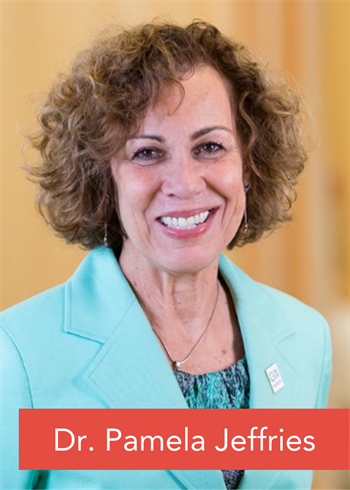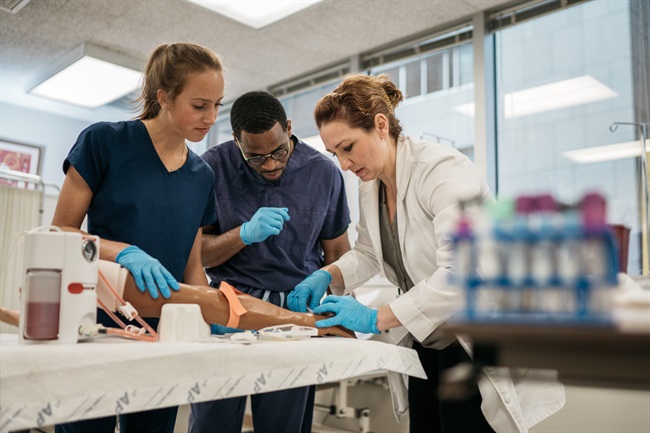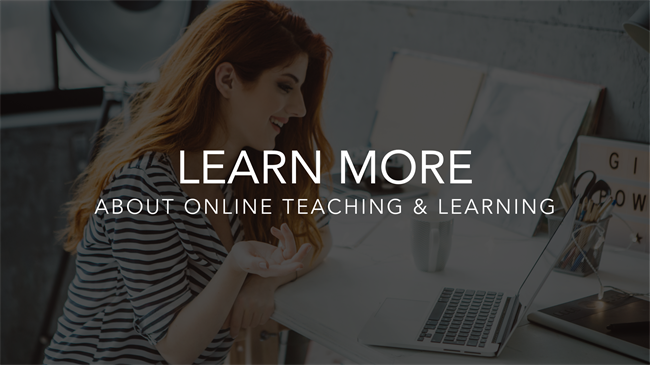Q&A WITH DR. PAM JEFFRIES: ONLINE LEARNING ACTIVE STRATEGIES
DISCOVER SOME BEST PRACTICES TO REINVIGORATE YOUR ONLINE EFFORTS
 Active learning and online learning became intertwined more closely than ever during the pandemic. Pamela Jeffries, PhD, RN, FAAN, ANEF, knows both topics well. We asked the Dean of Vanderbilt University School of Nursing (and former Professor and Dean at George Washington University’s School of Nursing) to provide some tips on how educators can better combine them for more effective teaching success. (This interview has been edited for length and clarity.)
Active learning and online learning became intertwined more closely than ever during the pandemic. Pamela Jeffries, PhD, RN, FAAN, ANEF, knows both topics well. We asked the Dean of Vanderbilt University School of Nursing (and former Professor and Dean at George Washington University’s School of Nursing) to provide some tips on how educators can better combine them for more effective teaching success. (This interview has been edited for length and clarity.)
Learn more about online teaching and learning
Question: Dr. Jeffries, you've studied online learning and developed some recommendations for best practices. Tell us about them.
Dr. Jeffries: I like to adhere to what are called the principles — the best practices. Chickering and Gamson studied them years ago and developed 7 principles of best practices, including active-learning, prompt feedback, student-faculty interaction, setting high expectations — those are a few. Those practices not only align with best practices in online learning but also in the classroom. And if you adhere to those 7 best practices, you're bound to be a wonderful teacher and engage students and have good faculty evaluations.
Q: Tell us more about active-learning strategies.
PJ: In online learning, it's great to diversify your activities, as well as your evaluation methods. One active-learning strategy I like is the 1-minute paper. The student simply has 1 minute to write a page describing a concept or linking a theory to practice. And you can vary it —3 or 4 paragraphs, or less than 200 words or less than 100 words. Basically, it's a quick assignment for the student, but they have to be concise in their writing. It’s also great for faculty who must grade the papers. It's something I can do very readily and get prompt feedback to the student. At the same time, I learn whether the student understands the concept.
Q: How do you grade those types of papers? What do you look for?
PJ: To grade a 1-minute paper, I create a rubric. A rubric sets criteria — 3-5 criterion — so the students can see what I'm grading on, whether it's conciseness or clarity on the concept or whether they need references. Whatever you're evaluating the students on, they need to be aware of those factors. How I’m grading shouldn’t be a surprise. Students need clear criteria and communication on how they're being evaluated.
Q: Thank you. Now, let's talk about the online learning community.
PJ: Online learning communities, I think, are very, very important. Online communities put students in a forum. If I have 30 students, I may have two communities: 1 community on practice and 1 on education. Then — in the communities — students can join their peers or colleagues in a smaller community within the larger class community. It's sort of like “birds of a feather flock together” — students join the community that they identify with or where they most want to post or read other people's posts. That's one example.
Another very simple one is an online café — also a small community, but one that’s more social. Students can visit that community and post questions such as, maybe they’re going to come to Washington, D.C., for the weekend. “Hey, are there any festivals or other events going on?” They might want to chat: “I'm having trouble getting a reference for this.” Basically, it's an open forum for your students that creates a community.
Q: How do students find these communities?
PJ: Faculty members set up the communities and can create one or several. I've taught many students before, and once, at a former institution where I worked, I had a class of about 50 students. I had two TAs with me, but instead of having 50 students in a large community, I made 3 communities, breaking the students up into groups of 20, 20, and 15. They were assigned to a specific community, but they could hop and visit the other communities if they wanted to. But they always posted in their own community. I oversaw one of the communities, a teaching assistant was in a different one, and the other T.A. was in another. So, we managed that very well. And students weren't overwhelmed seeing 50 to 60 postings; they only saw the posts in their community.
So, setting up communities like that allows faculty to manage more students and still gives them the quality education needed, in addition to prompt feedback, which is a best practice in education.
Q: What online platform do you use for the communities?
PJ: That’s a great question. Most universities have their own learning management system (LMS). I happened to have used Blackboard, but there's Canvas and other platforms out there. I like using a setup learning management system, because once I do an online course, students get used to coming into it. It’s best to set up your LMS with a consistent format: where the overview is found, where it's divided by modules, how Module 1 is covered during these weeks, etc. In addition, make sure assignments are always found in one place, so students don't have to go on a scavenger hunt trying to find them. Students want consistency and organization. That's very important.
The other endeavor I’ve used when developing courses is following “Quality matters,” a national standard benchmark. If you look at the criteria, it's about how to develop a course, but you also set online net etiquette on how students should respond to each other in an online platform, along with an overview of course objectives. Also, I establish virtual office hours. There are all kinds of criteria to meet “Quality matters” to make a quality online course.
Q: Let's talk about debate.
PJ: That’s another active-learning strategy. When I set up a debate, I’m putting students in different learning circles or communities. I set out a topic on something like policy. I assign some students to the pro side and others to the con side. Then I put another group of students into a group for listening, asking questions, and summarizing at the end. So, I end up with 3 learning communities — pro, con, and questioning/summary.
As an active-learning strategy, students must get together, talk, and develop their strategy, whether they are pro or con. Then the third community decides what questions they want to ask. They won't know how to summarize until they hear the debate between the pro and con groups. This can be asynchronous, where you set a deadline for discussions to end. Or it can be synchronous, where I want all students to come online at, say, Wednesday at 3 p.m. so we can have the debate in real time. And the debate can be archived for students who can’t attend.
Online learning provides flexibility, which provides education mobility and career advancement for many students. So, I tend to stay away from synchronous, because that means students — even though it's online — still must report by Wednesday at 3 p.m. For many of them, that's a barrier if they can't get away. That's why they're online in the first place. So, I prefer asynchronous.
Q: As important as learning techniques are, educators also need effective ways to evaluate student learning. What guidelines do you suggest?

PJ: Selecting evaluation strategies — that's very, very important for your online course and important for faculty, who need to understand whether students are grasping the concepts or the material knowledge skills. I like to diversify my evaluation techniques. But, again, they need to be manageable for the student, as well as manageable for the faculty.
One technique I mentioned earlier was the rubric. Rubrics are important, because they outline the criteria with points assigned. So, you get 5 points if you meet this, 3 points if you don't quite meet it but you almost meet it, etc. But it's very clear to the student — the learner — on how they're going to be graded.
Other evaluation strategies include multiple-choice tests and minute quizzes — like a 10-point quiz that can be graded very quickly by the computer when they go online. I tend to time those tests, particularly when online students are in remote areas. I allow a minute for each quiz question — so 10 minutes — so you know they're not looking everything up in the book.
For a high-stakes test, or if it's multiple choice, you can use secure remote proctoring.
Q: What about portfolios as an evaluation strategy?
PJ: Portfolios are a larger endeavor where there’s an iterative process throughout the course where students are adding — component by component — to get to the large project at the end. For example, I taught an online course once on how to develop an online module for online teaching. Students ended up creating a portfolio at the end of the course developed from a wiki. The first few weeks, they had to develop the overview of the intro of the module. The second/third week, they had to write the objectives and the evaluation strategy. They compiled pieces each week. Then, around week 4 or 5, they had the content for their module. With each new piece, they added to their wiki, which was the repository for all this material. And, at the end, they had the project fully accumulated.
Q: And you evaluate those projects on a rubric too?
PJ: Usually, you can evaluate projects on a rubric. But, if not a rubric, I make sure I provide clear criteria on the grading points, such as 30 points on content, 20 points on the overview, 10 points on the references, etc. Or, maybe, overall, it’s 10 points on clarity and conciseness in the writing. But, again, it should not be vague to students how they're being evaluated.
Q: What about reflection papers?
PJ: I really enjoy reading those. Usually, these papers are guided reflection — reflective practice — particularly with students after going in a clinical setting. Often, it's an “Aha!” moment for me when I read what they’ve reflected on. You might think they would reflect on their patient or the diagnosis or the first time giving an injection or starting an I.V. But many times, when they reflect, they're reflecting on something totally different that impacted them that was personal or that related to them because of their grandmother or whatever. But they're reflecting on their clinical and then putting it in writing.
The writings usually are beautiful to read. And they give me more of an insight into my learners and what's important to them, but also whether they are making the connection from theory to practice or they're demonstrating the affective domain, the caring, the compassion — those are all found in reflection papers.
Q: Do you give them direction on what the topic of the reflection paper should be? For example, “Talk about the most recent clinical experience you had.” How do you get them started?
 PJ: I think, as far as direction on reflection papers, it can go either way. You can just say, “What was your most memorable moment? Reflect — in a 1-page paper or a 1-minute paper — on your practice today in clinical.” Or you could say, “I want you to reflect on some dynamic interaction you heard with your patient and family, or nurse to patient, and reflect on that communication.” Or you might have them reflect on an interprofessional team encounter. So, you can make it very specific, or it can be just open.
PJ: I think, as far as direction on reflection papers, it can go either way. You can just say, “What was your most memorable moment? Reflect — in a 1-page paper or a 1-minute paper — on your practice today in clinical.” Or you could say, “I want you to reflect on some dynamic interaction you heard with your patient and family, or nurse to patient, and reflect on that communication.” Or you might have them reflect on an interprofessional team encounter. So, you can make it very specific, or it can be just open.
Q: Is there another active-learning technique you recommend?
PJ: One of the important indicators for success and online learning and teaching is prompt feedback. As faculty, I need to get back to my learner. Even if I can't grade their paper or get back them today, I tell them, “You know, today's Monday. I will get back to you by the end of the week but thank you for your submission.” That way, students at least know I received it; it's not in cyberspace.
Students want that interaction, even if it’s brief. And that's a quality indicator for online education. Any time you do evaluations — when you see faculty in online teaching get high marks — it will be due to that prompt feedback. Students want to know they're engaged and that their faculty care.
One of the reasons I love online teaching and learning and appreciate the platform is because, for many learners, they're working. They're working mothers. They're working fathers. And they can't stop their careers to come and go to class. So, with online teaching and learning and online programs, we provide educational mobility and career advancement for those learners. Without the online platform, many would never advance in their education.
I feel very strongly about online learning. It can be done in a high-quality manner. In fact, we have over a decade of evidence showing online learning is just as powerful as face-to-face. I know, many times, there are naysayers about online learning and education. "It's not as good. They're not in the classroom." But there's strong evidence that learning does take place with great outcomes, and — again — online learning provides the education mobility and career advancement for our students, our learners, our new graduates to move them to the next highest level.


